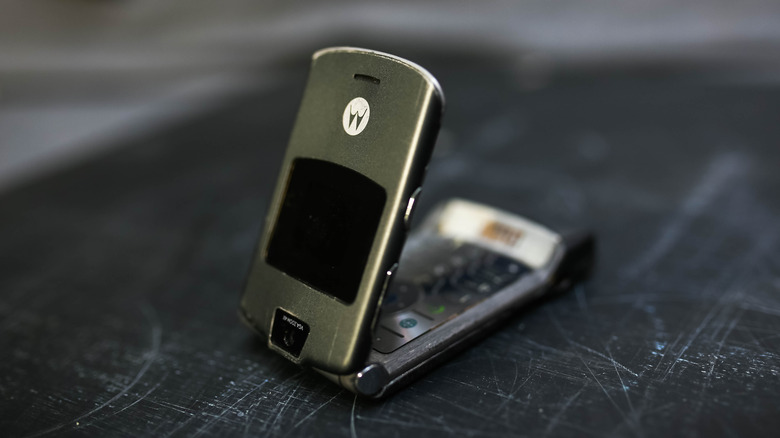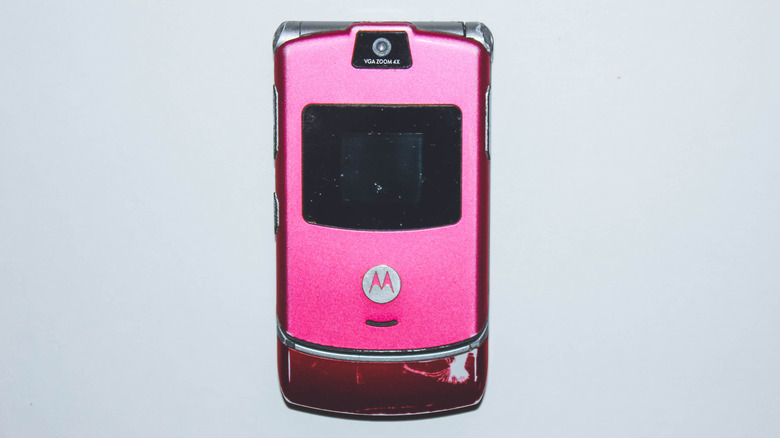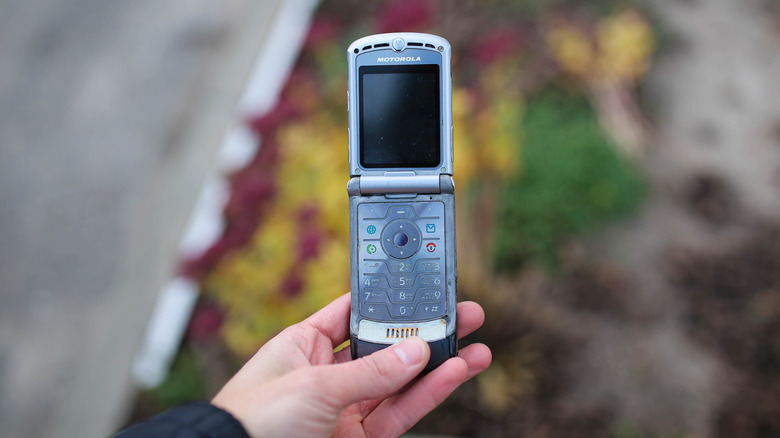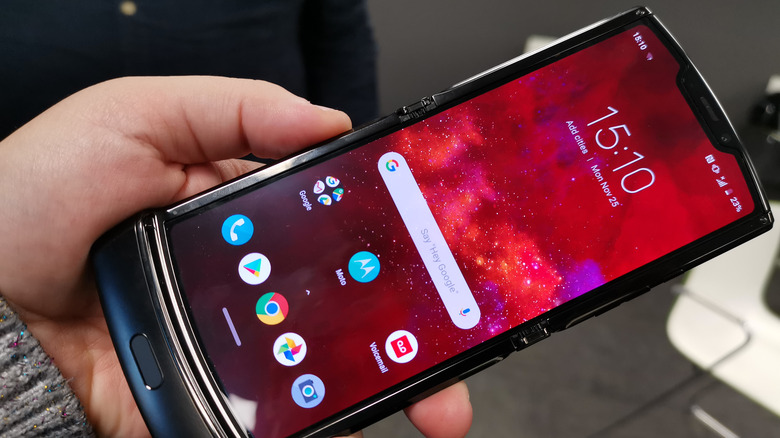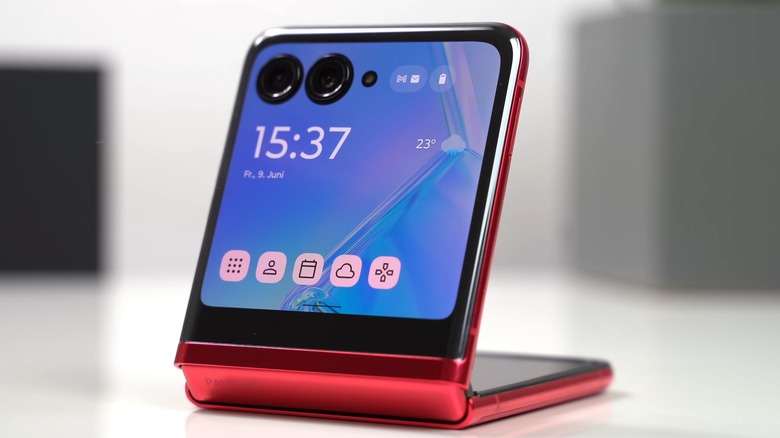Why Motorola Discontinued (Then Revived) The Razr Phone
There aren't many phones out there that command the same level of nostalgia and nigh unassailable grip over pop culture as the clamshell Motorola Razr. The phone's market debut was no less glitzy. It made its global debut before fashion journalists at the Arken Museum of Modern in Copenhagen.
"When you think [of] Y2K and fashion, the Motorola Razr was an accessory, and I made it that way. I would literally have low-waist jeans and have it just clipped in there," socialite and actress Paris Hilton reminisced to Billboard in June 2024. The Razr appeared in the Academy Awards goodie bags. Sports legends and fashion icons such as David Beckham and Maria Sharapova also inked business partnerships with the company.
The demise was quick, sad, and paved the way for Android and iPhone dominance. So it came as a surprise when, in January 2019, The Wall Street Journal first reported that the Razr was en route to a revival. Motorola confirmed its intentions a few weeks later, and in early 2020, Motorola brought back the Razr as a foldable phone priced at $1,500.
The market has once again become fiercely competitive with clamshell phones rocking a flexible panel, but so has Motorola. It seems the company is focused on leaving behind the Razr V3 demons. What follows is the journey of how the Razr fell into ignominy and then made a strong comeback over a decade later.
What broke the Razr?
The Razr was a must-have style statement, and was so popular that — despite Motorola barely revising the hardware — the flip phone continued to be a best-seller for 12 straight quarters.
Yet, everything eventually runs its course, and the Razr was no different. "While Motorola earned hundreds of dollars of profit on each Razr during its first year, it makes little on the newer, heavily discounted Razrs — a precipitous drop in profit margin that was behind last quarter's earnings shortfall," reads a 2007 article in The New York Times.
Motorola's mobile device unit went from showing almost a billion dollars in profits to hundreds of millions of dollars in losses within a year. Motorola executives cited in the story note that the company was desperately looking to boost its market share, and in a bid to do so, the company pushed drastic discounts that only shrunk its profit margins.
"There's no part of this company that's really doing very well," Joan Lappin, president of New York-based Gramercy Capital Management, was quoted as saying in a Sydney Morning Herald article. "There's just nothing special going on there anymore." But shrinking profits weren't the only reasons Motorola and the Razr slipped into decline.
Growing out of touch
The Razr was once a hot accessory for not just the hip and young, but also Wall Street folks eager to flash their taste in the telephony gizmos. But it seems Apple had gained some unexpected popularity with its first iPhone — not just among the young and affluent, but also the older user base that was enamored by its fresh appeal, as per market analysis data from Strategy Analytics cited in this WIRED article.
Motorola's newer devices weren't gaining fans, either. "Analysts and consumers view many of these new phones as mere Razr knock-offs, with derivative, vowel-challenged names like the Pebl, Slvr, Rizr and Rckr," adds the Times report cited above. Another analyst bluntly put that Motorola simply failed to serve a hit as big as the Razr. If one takes into account the rapidly changing landscape of the mobile industry, the writing had been on the wall for a while.
"It doesn't contain Motorola's sucky operating system, an OS which is so frustrating that, in combination with the handset's sharp edges, makes it a potentially lethal weapon," says a 2008 WIRED article, comparing the Motorola Razr with the fluid software introduced by the iPhone.
A decade later, Motorola staged a comeback, at a time when the iPhone sits at the summit. However, the comeback can't solely be credited to the industry getting a taste of foldable innovation and Motorola's eagerness to get an early lead — something it missed when the iPhone arrived on the scene with its touch-first interpretation of a mobile phone.
The comeback
The return of the Razr was a slow journey. Jim Wicks, Motorola's head of design, didn't rule out a comeback for the Razr in a 2013 interview with The Verge – years after the Razr V3 had been discontinued and the company was knee-deep into the Android world. Motorola was the first to launch a clamshell-style foldable phone, but it was a work nearly half a decade in the making, and beat Samsung to the market by a hair.
"We didn't set out to recreate the Razr. Turns out, the world was ready for another Razr," Jeff Snow, a Product General Manager at Motorola, said in an official sizzle reel. According to Glenn Schultz, Vice President of Innovation & Product Development at Motorola, it took the company four years to create the foldable Razr.
"So we're trying to understand what we can do to revive some of that but it's got to be done in a way that fundamentally delivers on incredible experience," Paul Pierce, who was a member of the original Razr's design team, told CNET back in 2018 about plans of reviving the Razr, a year ahead of the foldable Razr's long-awaited introduction, which was the culmination of a process that entailed over 100 patent filings. "It can't be done just for a gimmick or something of that nature. We've got to figure out how to deliver a breakthrough," he added.
"It's new technology. There are good days and bad days, but we want to feel that it's really mature before going to market," Motorola President Sergio Buniac said in another CNET interview. A total of 26 prototypes were created before the team finally landed on the desired clamshell design, notes Laura Joss, Global Director of Design Research at the company.
Where the Razr stands today?
Marshall Brown, Executive Director in the Product Division, remarked that "it just feels good," showing how one can close the phone shut with a satisfying sound in the same video. Of course, that cool close was one of the hallmark features of the original Razr that propelled Motorola to new heights of popularity and brought billions of dollars in revenue.
"Our vision was to create an ultra-compact device that fit comfortably in your hand, or your pocket on the go, but could open to reveal a fully functional smartphone," said Executive Director and Country Head for Motorola India, Prashanth Mani, at the phone's launch in India. "We quickly realized this wouldn't be possible if the phone unfolded into a tablet. It's too unwieldy. Instead, we opted for the clamshell design. Creating a modern interpretation of our iconic flip phone was the right way forward."
Over the past five years, Motorola has expanded the Razr lineup, arming it with top-tier silicon, better cameras, and a refined design that includes a dramatically bigger — and functional — cover screen. At the moment, the company's latest clamshell foldable phone in the iconic series is the Motorola Razr 50 Plus, which also tags alongside a more affordable variant packing a smaller screen. While sales figures for the range haven't been officially disclosed, it's telling that in 2024, it's possible to pick up a 2023 model Razr for under $400.
Motorola has not only managed to undercut Samsung, on the pricing front, but has also managed to serve a design that is cleaner and more practically rewarding than the Galaxy Z Flip series phones. It's quite not the dominance that was once enjoyed by the Razr V3, but the current slate is on the right track.
